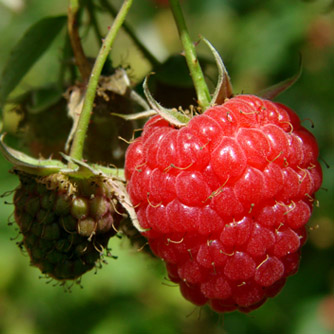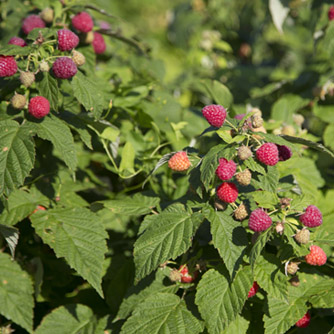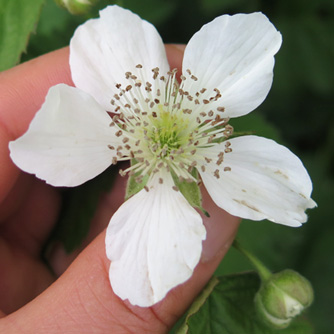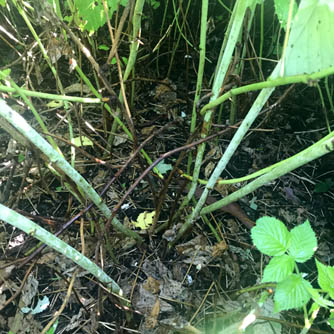Raspberries
BackRaspberries are an easy and rewarding backyard crop to grow. Once established they’re extremely productive and of course taste incredible picked fresh from your garden. Plus if you’ve got the space to grow more than one variety then you can extend your raspberry harvest all the way throughout summer and well into autumn.
Traditionally they’re thought of as a cool climate plant and it’s said that if you live in an area where you can grow apples then you can grow raspberries. However there are also varieties suited to warmer and even tropical climates so everyone can enjoy homegrown raspberries!
How to Grow Raspberries
Raspberries (Rubus idaeus) grow on canes reaching 1-2 metres high. They need rich fertile soil which is free draining and on the slightly acidic side. Raspberries are frost hardy and in cooler climates they can be planted in full sun. In regions with hot dry summers position plants so they get some afternoon shade and are protected from hot winds. They’ll appreciate enough water during summer to keep the soil moist.
Raspberries are deciduous plants and are commonly planted as bare-rooted canes in winter when they are dormant. It’s at this time you’ll find the largest range of varieties available from garden centres or online nurseries.

Ripening raspberries
Raspberry canes should be spaced around 50-60cm apart and planted next to a reliable support structure about 1.5m high like a metal archway, wire fence or sturdy teepee. This is important to help manage their growth and prevent them become a tangled mess.
Before planting soak the bare-rooted canes in a bucket of diluted OCP eco-seaweed for a couple of hours to stimulate better root development. In the meantime prepare the soil by mixing in plenty of compost and aged manure. Raspberries really like rich soils and the extra organic matter will help retain moisture. Then dig your hole, place the canes in and spread out their roots. Back fill the hole and press down firmly. Pour the bucket of diluted eco-seaweed over your newly planted raspberry to help settle the roots.
Mulch around the canes to help retain moisture and keep the root zone of the plants cool.
Fertilising Raspberries
Once the plants break dormancy in early spring fertilise your raspberry plants fortnightly with a mix of OCP eco-aminogro and OCP eco-seaweed to encourage lots of growth which will mean more fruit later in the year. Plants will also benefit from a topdressing of compost, manure or organic fertiliser pellets every spring and autumn. Remember these guys really do love fertile soils!
Pruning Raspberries
Broadly speaking raspberries can be broken to two groups: summer fruiting and autumn fruiting. It’s important to know which type you have because this will determine how the plant fruits and then how you prune it.

Check the raspberry patch regularly and harvest individual fruits as they ripen over several weeks
Summer fruiting varieties bear fruit on 2 year old canes. Here’s how the cycle works. When a new cane (called a primocane) emerges from the ground in spring it spends that first year growing leaves and a long main stem. In its second year the cane is called a floricane and it changes to growing lateral shoots where the flowers and fruit develop. Once fruiting is finished that 2 year old cane will die off. Don’t despair though because in that second year new primocanes will have been growing in the background. So from now on your raspberry patch will be a mix of primocanes and floricanes giving you yearly harvests.
To keep your raspberry patch under control and maximise yield cut off all the finished floricanes at ground level. This will make it easier to see the replacement primocanes canes. These should then be tied to your support structure.
Autumn fruiting varieties are slightly different. They produce fruit later in the season (obviously) but on the first year canes. So once the plant has finished fruiting you simply cut all the canes back to ground level and tie up new canes as they emerge.
Harvesting Raspberries
Harvesting fresh raspberries and eating them immediately has to be the BEST reason to grow your own. The fruit is ready to pick when you can tug gently and it comes away from the stalk with little resistance.
Fruit is usually ready 3-4 months from flowering and depending on the variety you are growing your picking window will last 4-6 weeks. If you grow a combination of summer and autumn fruiting varieties you can extend your cropping season from weeks to months.

Raspberry flowers will appear in spring or summer depending on the variety
Pests and Diseases of Raspberries
Here are the main things to watch out for:
- Root rot (Phytophthora) – unfortunately raspberries are susceptible to this disease which can quickly kill the plants. To reduce the chance of this occurring always purchase certified disease-free canes and make sure the soil is free draining with a high organic matter content.
- Fungal issues – there are several fungal diseases which can attack the foliage, canes or fruit. Yearly pruning and tying up the canes will go a long way to reduce disease incidence by improving airflow. If you experience problems try weekly foliar sprays of OCP eco-seaweed to strength cells against attack. If necessary then apply an organic fungicide.
- Scale – sometimes scale can develop along the canes. Treat with an organic oil spray.
- Aphids and Mites - treat these sap sucking pests with a horticultural oil and repeat spray as required.
- Viruses – distorted, stunted or yellowing growth may be due to viral infection. Many viruses are spread by sap sucking pests (like aphids) so always control them at first sight. However the most common virus in raspberries (Raspberry Bushy Dwarf Virus) is actually transmitted via pollen so bees and other pollinators will spread it. Virally infected plants can’t be saved and should be removed.
- Birds – if birds discover your ripening raspberries then act quickly to protect your tasty crop. There are various deterrent products/tricks around but realistically netting is probably the most effective option. Always choose a fine netting, with holes smaller than 1cm, so the birds don’t get caught in it.

If left unmanaged raspberry canes quickly get congested
Raspberry Varieties for Temperate and Cool Climates
- ‘Sandford’ - An early summer fruiting raspberry that produces fruit from early December so you can have raspberries for Christmas. Yes please!
- ‘Chilcotin’ - A dual-cropping high yielding variety. You’ll get the main crop in summer (on the floricanes) but followed by a smaller secondary crop in autumn (on the tips of the primocanes). Great one to choose if you only have space for one variety. Completely prune away the finished floricanes but for the fruited primocanes only remove the very tips and leave the rest as these will develop the summer crop next year.
- ‘Chilliwack’ - A mid-summer fruiting variety that is almost thornless making it great for kids to harvest.
- ‘Autumn Bliss’ - As the name suggests this variety produces large, sweet fruit in autumn.
- Native raspberry (Rubus parvifolius) – indigenous to the eastern side of Australia it usually grows around 1 metre high. Fruiting can occur from summer to autumn.
Raspberry Varieties For Warm Temperate, Subtropical and Tropical climates
- ‘Heritage’ - A hardy and vigorous raspberry, well adapted to thrive in climates where the winters are mild. It’s an autumn fruiting variety so fruit is produced on new canes.
- Atherton Raspberry (Rubus probus) – This is another Aussie native growing that comes from tropical rainforests and fruits throughout summer and autumn. Its flavor is milder than the introduced raspberry but still very tasty. It’s a vigorous grower reaching 2 metres high. Some people grow it in a large pot to keep it under control. Can be grown in frost-free temperate climates as well.


